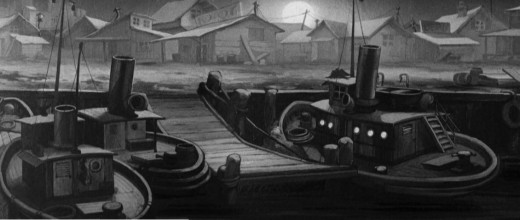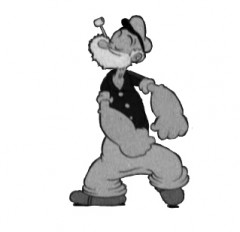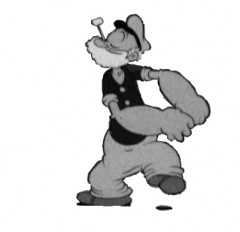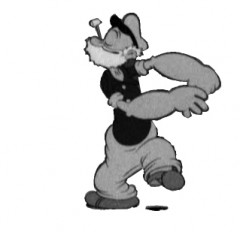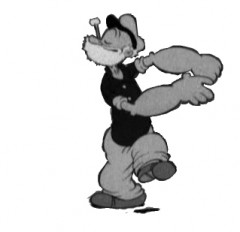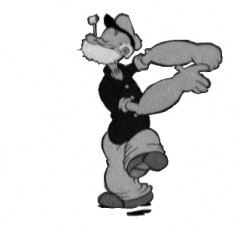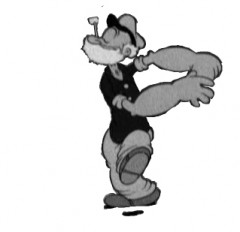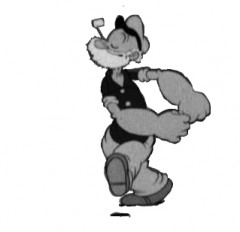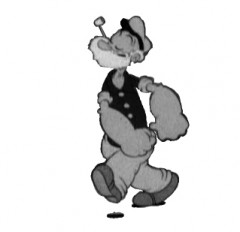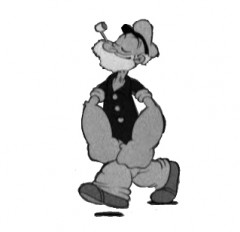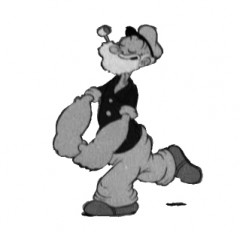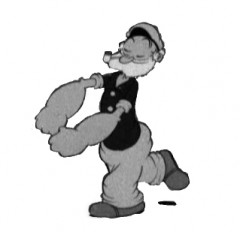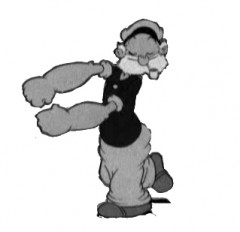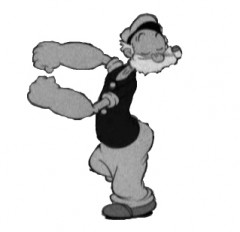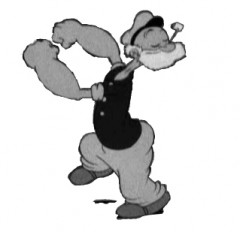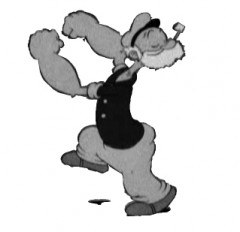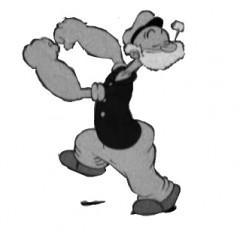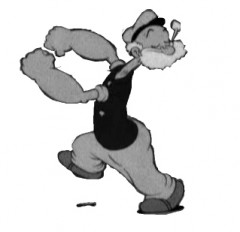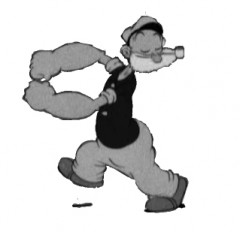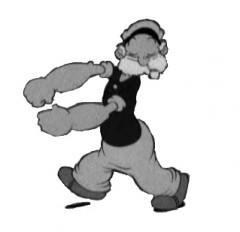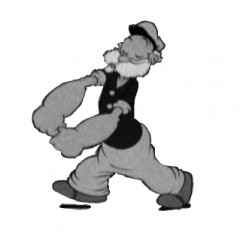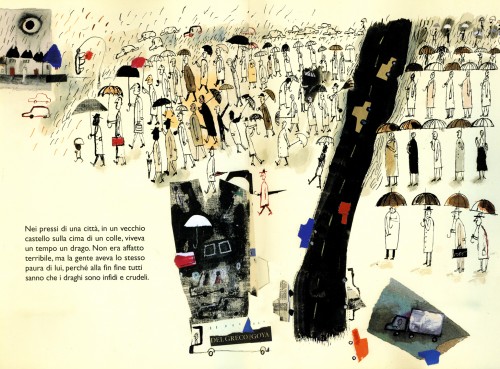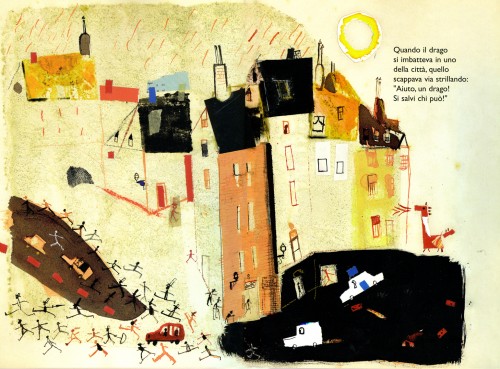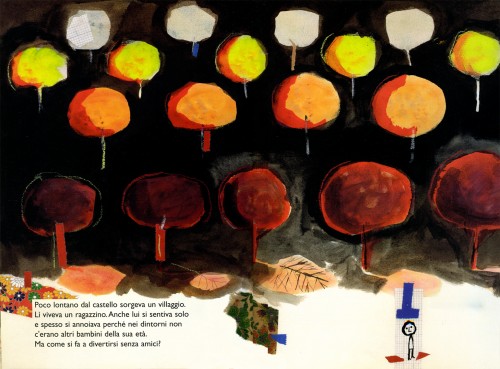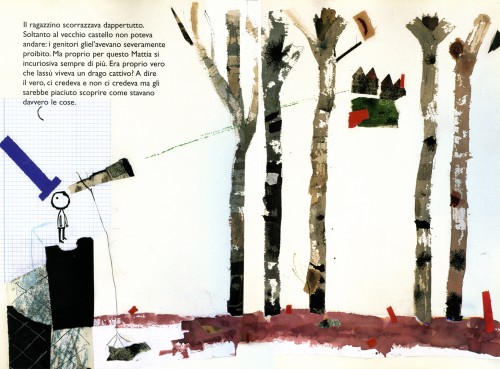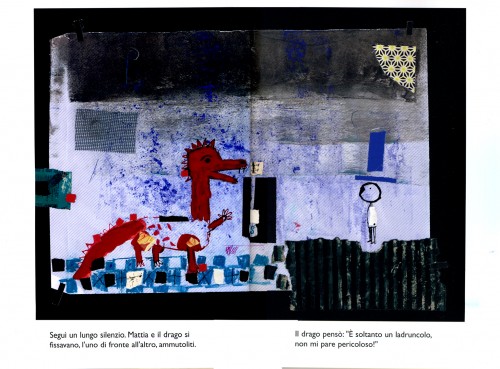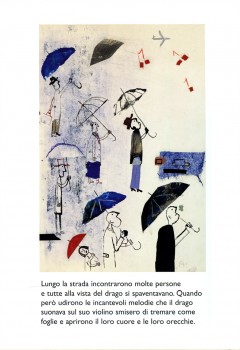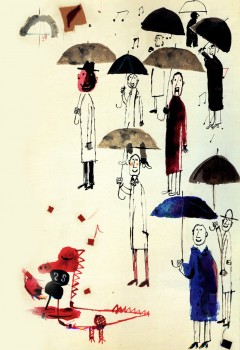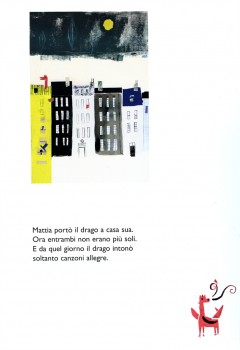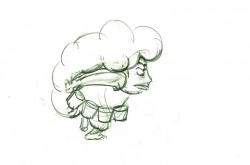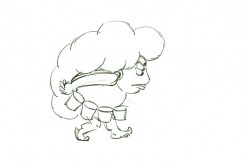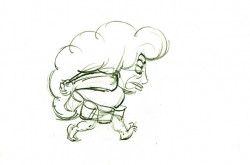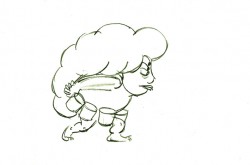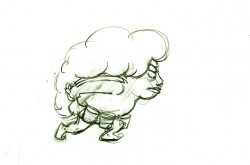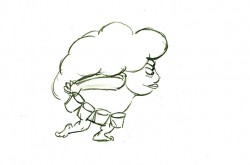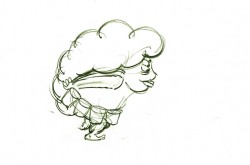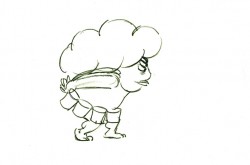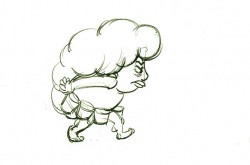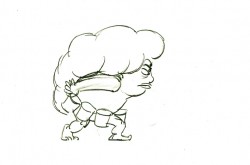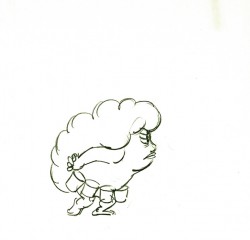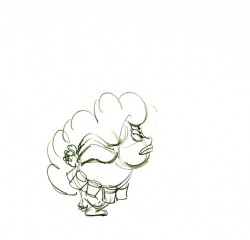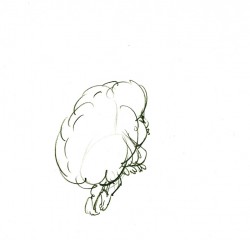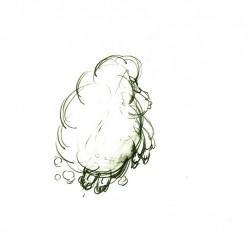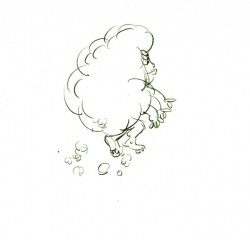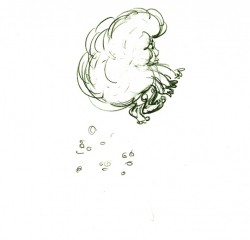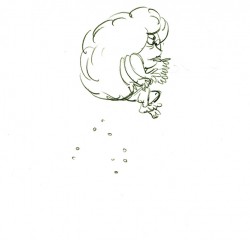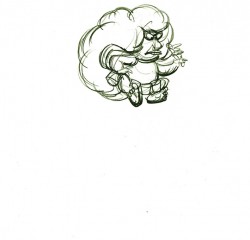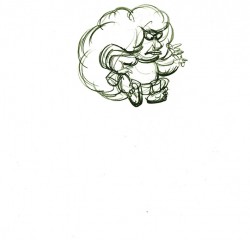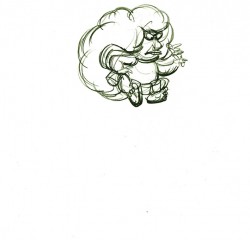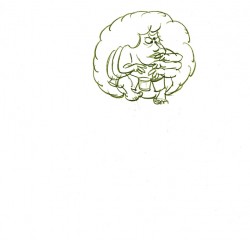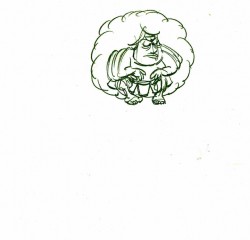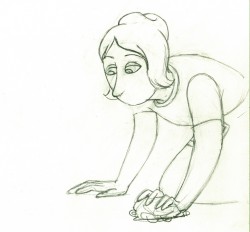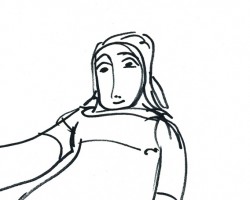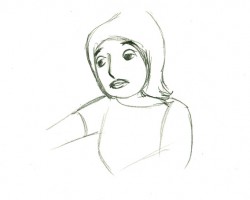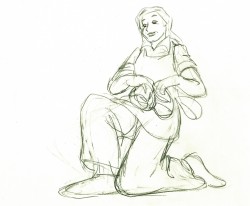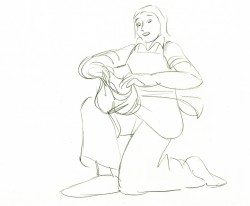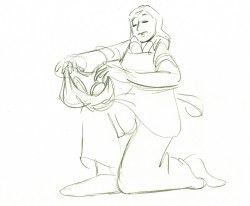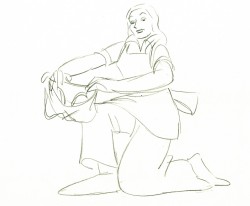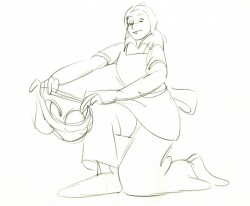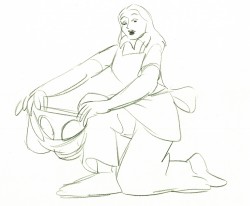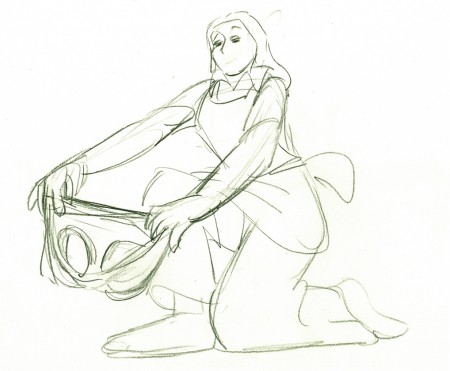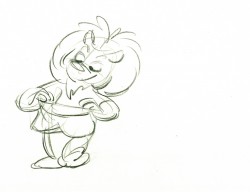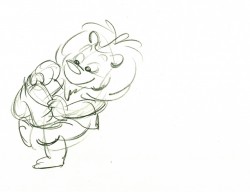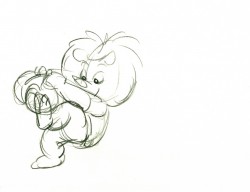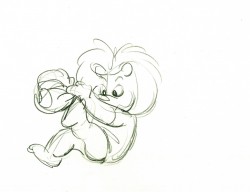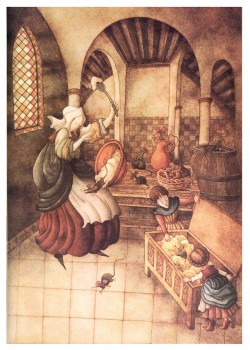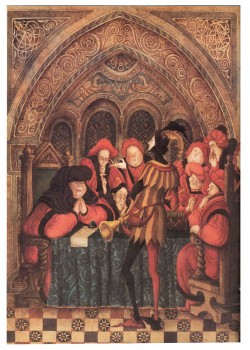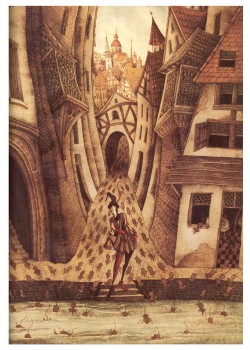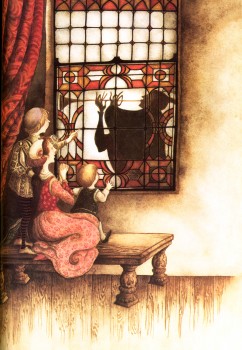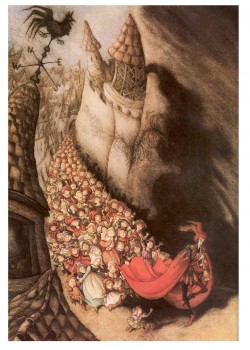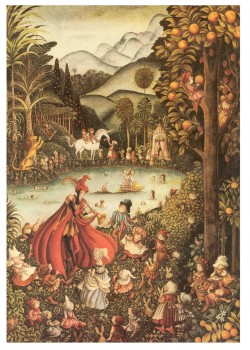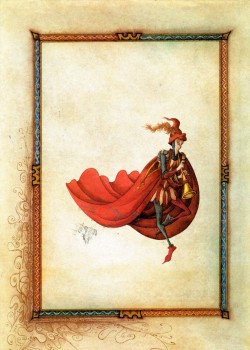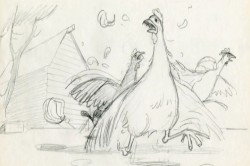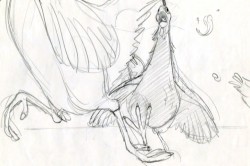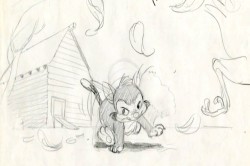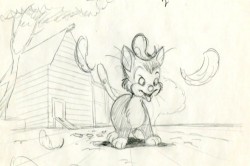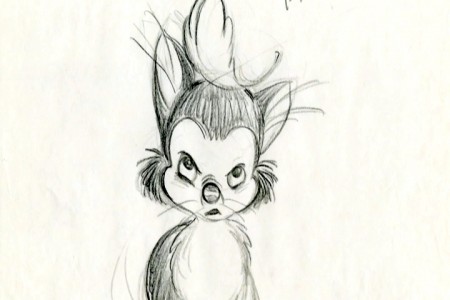Monthly ArchiveApril 2009
Fleischer &Frame Grabs 10 Apr 2009 08:04 am
Poopdeck Pappy Breakdown
- Following up yesterday’s post, here’s a scene breakdown of the Popeye film With Poopdeck Pappy. This short’s a delight. Done in 1940, it has that textural beauty the Fleischer shorts seemed to inhabit during this short period from about 1937 – 1942.
Bill Nolan was the key animator (animation director) of the short with Winfield Hoskins (I’m not sure who he was) receiving the only other credit. Nolan was known for his incredible speed, so it’s quite possible he animated the lion’s share of this short.

(Click any image to enlarge.)

Pappy walks up in perspective then across the screen
from left to right until he reaches the club.
Animation &Fleischer &Frame Grabs &walk cycle 09 Apr 2009 08:00 am
Poopdeck Pappy’s walk
I received this delightful note from Borge Ring:
dear michael ♫♫
You sometimes bring stuff on Popeye
There is a Popeye I like very much. It was animated by Bill Nolan in 1940 and the title is Poopdeck Pappy.
I stumbled on this short on internet and realised why Preston Blair had such a high opinion of Nolan.
Blair is quoted by – if I remember right – Charles Solomon in his book.
writes
Børge
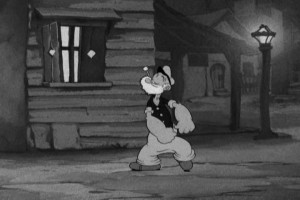 So I ran back to the film (which I know very well.) I’ve made a lot of frame grabs and was going to do a sort of mosaic (without the information that a draft might give me), but it’s taking a lot of time.
So I ran back to the film (which I know very well.) I’ve made a lot of frame grabs and was going to do a sort of mosaic (without the information that a draft might give me), but it’s taking a lot of time.
Consequently, let me make a post of this brilliant walk. There are many of them in this film and lots of hilarious dances. It’s all so balletic and rhythmic. I urge you to listen to Børge, watch the film again. It’s an absolute beauty; this is my favorite period of Fleischer’s work.
Here’s Poopdeck Pappy’s jaunty walk:
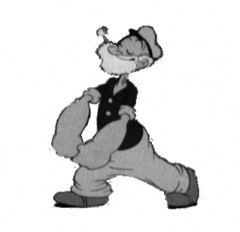 1
1 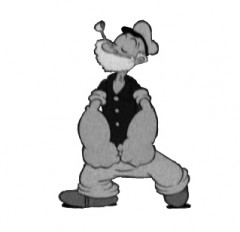 2
Poopdeck Pappy’s walk cycle
2
Poopdeck Pappy’s walk cycleOn ones at 24FPS
Click left side of the black bar to play.
Right side to watch single frame.
Books &Illustration 08 Apr 2009 07:48 am
Un Drago Troppo Solo
- John Canemaker knows that I love great children’s book art. He’ brought this book to my attention and loaned it to me to post some of its illustrations. Un Drago Troppo Solo (Only a Dragon Too) is a beautiful Italian children’s book written by Doris Diedrich and illustrated by Javier Zabala.
It’s the story of a bored boy who tames a dragon. The illustrations are right out the Abstract Expressionist handbook. Using collage, bits of tape, graph paper, splattered paint and strong expressive painting, the illustrations are distinctive and inspiring.
Here are a few of the book’s illustrations:
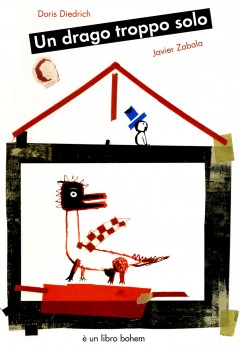
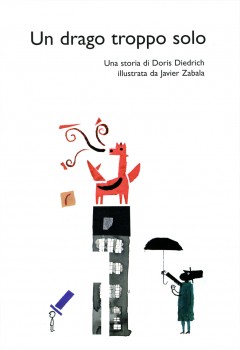
The front cover | the Title Page
Animation &Animation Artifacts &Hubley &walk cycle 07 Apr 2009 07:50 am
Phil Duncan’s walk cycle
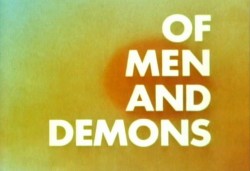 - Phil Duncan was a mainstay of the Hubley animators in all the time I was there.
- Phil Duncan was a mainstay of the Hubley animators in all the time I was there.
You could tell who Hubley’s favorite animators by the frequency in which he doled out sequences to them. Whereas Tissa David or Bill Littlejohn or Barrie Nelson would have been asked to animate entire shorts by themselves, someone like Phil Duncan would get whole sequences to animate. At the same time, John so depended on Phil and trusted what he did.
There were never pencil tests at the Hubley studio. Only one instance of it do I remember, and that was on the Art Babbitt mime scenes from Carousel. As I said once before, I remember John running out to get me asking if I’d like to see animation as good as I’d ever see. We then watched the PT over and over together. Ultimately John took Art’s animation on twos and had me put it on four frame dissolves to get more screen time out of it. A budget was a budget and you had to make the most out of the excellence you had in your hand.
But as I mentioned yesterday, Phil would animate on odd numbers expecting the even numbers to be inbetweened. Most times, John asked me to reexpose the scene on fours and not do the inbetweens. Of course, Phil was aware this would happen and had planned on it.
.
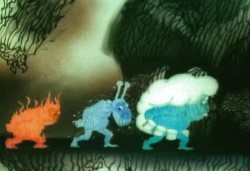
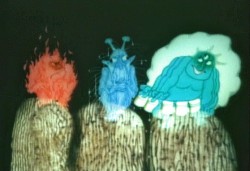
Here is a walk cycle (and more) by Phil Duncan from Of Men and Demons, which was nominated for the Oscar in 1969. The full scene includes the three demons walking and then flying up to their cave.
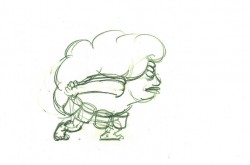 1
1 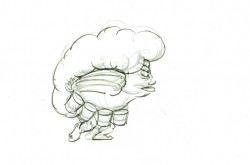 2
2
(Click any image to enlarge to full animation paper view.)
The rest of the scene breaks out of the walk cycle. I
enlarged the frames to accomodate the remainder of the action.
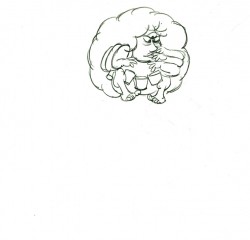 23
23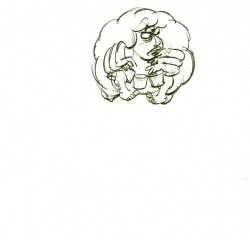 24
24
On threes at 24FPS
Click left side of the black bar to play.
Right side to watch single frame.
Animation &Animation Artifacts &Hubley 06 Apr 2009 07:31 am
Phil Duncan’s Carousel
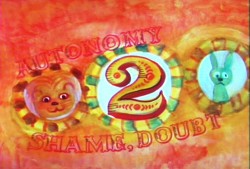 - There’s an odd conversation going on at the Animation Guild Blog. It started out with the traditional CG vs hand drawn argument, then it morphed into who get the better salaries and the greater recognition.
- There’s an odd conversation going on at the Animation Guild Blog. It started out with the traditional CG vs hand drawn argument, then it morphed into who get the better salaries and the greater recognition.
Quite a few brilliant animators passed under the limelight and never got quite the credit they deserved for their long and dedicated work in the medium.
Phil Duncan certainly belongs in this
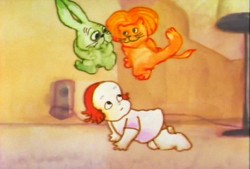 category. I never got to meet him while working at the Hubley studio, but I assisted many of his scenes, spoke with him and came to know his style well.
category. I never got to meet him while working at the Hubley studio, but I assisted many of his scenes, spoke with him and came to know his style well.
He worked for many years animating at the Disney studio, starting on Pinocchio and working his way up into the early 60s. He animated on Magoo’s 1001 Arabian Nights and Gay Purr-ee for UPA.
His work for Hubley began with The Cruise in
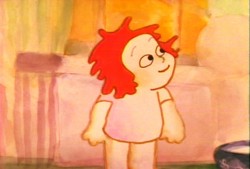 1966 and continued through many of the important films right up to John’s death in 1977. Phil’s work on Watership Down began with John Hubley and continued with Martin Rosen.
1966 and continued through many of the important films right up to John’s death in 1977. Phil’s work on Watership Down began with John Hubley and continued with Martin Rosen.
I got to assist many a scene Phil animated for shorts, commercials, Electric Company spots etc. I also followed him through many scenes on the feature, Everybody Rides The Carousel.
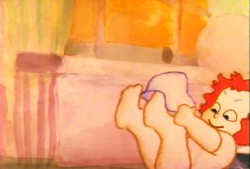
His style was so different from all the other animators I mentioned that it was a delight for me to work behind him. His line was always this great feminine stroke that featured plenty of arcs and curves. He usually left only one inbetween between drawings, and he knew that often enough John Hubley would say to put the scene on fours and not inbetween it. I remember breaking the news to Phil the first time I saw this happen. There was an ever-so-slight downturn in his voice, but it was obvious that he expected this to happen.
Believe me, he wasn’t the only animator who heard me break this news. The films were done on such a tight budget that every penny counted. It did give me some power, because I would judge the scenes to see if I felt there was any point that we couldn’t get away with it, and if that were the case I would inbetween it while inking the drawings. John didn’t need to know, and I worked quickly enough so that it didn’t cost him much more of my salary.
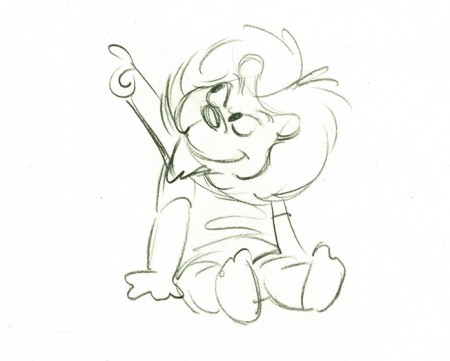 57A
57A(Click any image to enlarge.)
Here are some drawings Phil did for the Toddler sequence from Everybody Rides the Carousel. Horse #2. The toddler can turn into a rabbit (meek) or a lion (daring.) Here she turns into a lion as she tries to dress herself with some help from her mother.
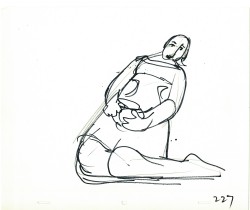
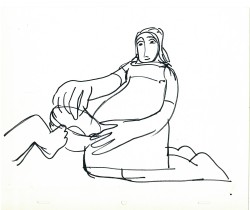
These are a couple of layouts by John Hubley.
Below, is a clean up that he sent to Phil Duncan of the mother’s head.
Here’s the next scene’s animation before it underwent some changes.
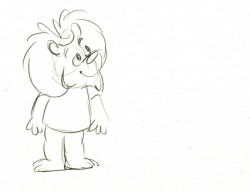 13
13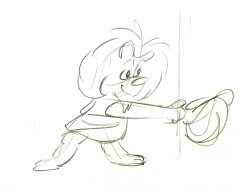 17
17
As you’ll notice from the frame grabs above, this sequence changed.
John wanted to go with the girl whose head, for a brief moment,
turns into the lion’s head. (Doubt) I did the change using most of
what Phil had on his original drawings.
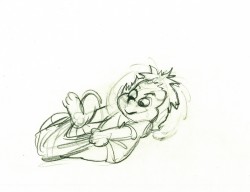 35
35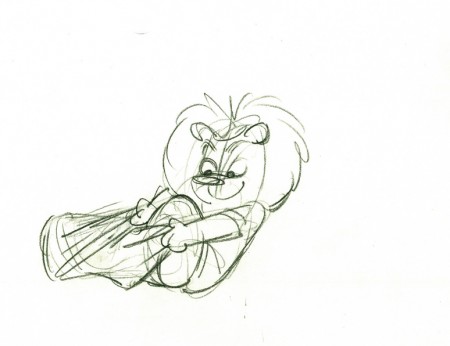 37
37
Note that on her hit down onto the floor #35, she turns back
into the toddler child before going back to the aggressive lion.
Photos 05 Apr 2009 08:34 am
Space Garbage Photo Sunday
Books &Errol Le Cain &Illustration 04 Apr 2009 09:14 am
LeCain’s Pied Piper recap
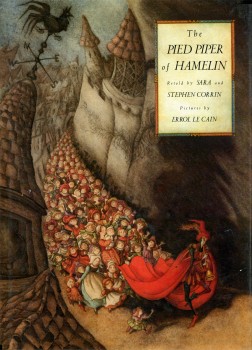 - After learning that Don Bluth et al were planning to do a film called “The Piper” prior to their working on Banjo: the Woodpile Cat, I wondered and assumed that it was probably The Pied Piper of Hamelin.
- After learning that Don Bluth et al were planning to do a film called “The Piper” prior to their working on Banjo: the Woodpile Cat, I wondered and assumed that it was probably The Pied Piper of Hamelin.
Many years ago as a child, I received a gift of a viewmaster projector, and it came with one title: The Pied Piper of Hamelin. Those slide shows usually came with a script that you could read along with each projected slide. I remember that this one came with the lengthy Browning poem. Reading it to myself, I loved it. So I memorized it (and still remember now some fifty years later.
I’ve always been attracted to versions of this story and often seek them out.
Errol Le Cain‘s illustrated a version of the poem, and here are some images from the book, The Pied Piper of Hamelin. It was first published in 1989 (the year he died). The book is an adaptation of Browning’s poem by Sara and Stephen Corrin.

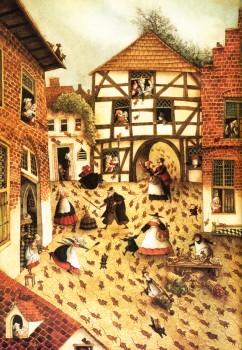
(Click on any image to enlarge.)
Commentary 03 Apr 2009 07:54 am
Banjo plucking
- Michael Barrier responded negatively to my comments on Don Bluth’s Banjo the Woodpile Cat. I thought to write a letter to Mike in comment, but decided it’d be more fun for me to post my response to his response here.
Let me break this down into two parts. The first addresses the funding of new animated projects.
- In my post, I said, “My only sadness is that the Bluth studio isn’t moving forward with more features . . . I wish he could engender the cash to continue on with the medium.”
To that, Mike said, “I couldn’t disagree more. Bluth is for me a white-bread Ralph Bakshi, someone who sucked up money that should have gone to other people, then used it to make terrible features that tanked at the box office and ultimately made it more difficult for good films to get made. If Bluth is finally on the sidelines, that’s cause for rejoicing. I hope he stays there.”
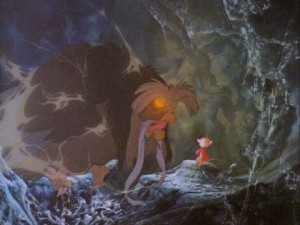 There’s an old saying within film circles: Any publicity is good publicity. That means getting a lashing from the critics is, in many ways, just as good as getting a rave. The idea is to get your name out there and to be noticed.
There’s an old saying within film circles: Any publicity is good publicity. That means getting a lashing from the critics is, in many ways, just as good as getting a rave. The idea is to get your name out there and to be noticed.
The same, in my mind, goes for animated films. The more the merrier. Just because a film or three fails doesn’t mean financing will dry up for everyone. Despite the obvious thought behind it, that’s a logic 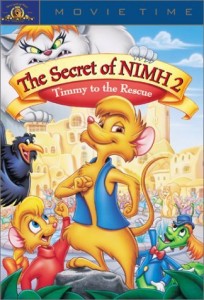 that has no real bearing on what happens within the film industry. There being a small number of animated features is what makes it more difficult. When a type of film is a rarity, it’s unlikely money people are going to trust another with their money. Make animated features commonplace, and it’s more likely money will come. As a matter of fact, another dozen features would make things easier.
that has no real bearing on what happens within the film industry. There being a small number of animated features is what makes it more difficult. When a type of film is a rarity, it’s unlikely money people are going to trust another with their money. Make animated features commonplace, and it’s more likely money will come. As a matter of fact, another dozen features would make things easier.
Given the state of 2D feature animation today, a Bluth film would be a gem in comparison to what’s out there. Somehow I can’t pin my hopes on Bye-Bye Bin Laden, now showing at the South Beach Film Festival. Who knows? Maybe it’s good, but for some reason my expectations aren’t high. It’s obviously a flash film chock full of stupid jokes, but it’ll do nothing to advance the medium AT ALL. Don Bluth’s attempt to do full and high character animation will advance it – if only to develop new and trained animators.
After Titan AE, the Bluth studio closed, but Fox turned to others that they’d used to help finish the film. That studio became what is today Blue Sky, employing lots of cg animators doing markedly different work from those on the West coast. To me that was a positive (regardless of whether I like Bluth OR Blue Sky.) There’s another studio out there generating lots of money for animated films.
Does it help the medium? If you’re just talking about getting more animation funded, then yes it does. Maybe one of these films will be good.
The second point has to do with what furthers the medium as far as quality is concerned.
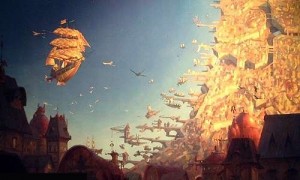 This is a tough one to respond to considering how negative I am toward most current animation.
This is a tough one to respond to considering how negative I am toward most current animation.
As opposed to the days when Don Bluth made Anastasia and Disney did Treasure Planet, we’re now living in an age of cgi animation. The best Hollywood theatrical features are predominantly cg.
Madagascar 6, Toy Story 5, Shrek 12, and Ice Age 9 aren’t going to advance the medium any more than that original Toy Story did. That film showed executives who originally didn’t even invest in collateral marketing (no dolls, no Woody Big Macs, no coloring books), that they could make a bundle from this new medium. They’d made an error in not supporting that film and had to make amends. Once you had the characters rigged, how easy it would be to do follow up films. Why waste time drawing all those cows for Home on the Range. Nickelodeon jumped in with Barnyard‘s ugly cg cows that were horrible in the film and no better in the series. But hey, they made money. Isn’t that what it’s all about?
Sorry Mike, gone FOREVER are the days of Snow White and Dumbo. Cinderella and Alice in Wonderland are gone. Even 101 Dalmatians and Jungle Book are gone. Hell, even Hunchback of Notre Dame and Treasure Planet are gone.
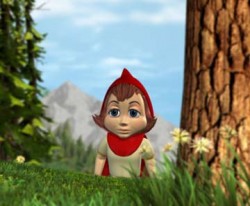 Today’s features are Hoodwinked and Delgo, Roadside Romeo and Space Chimps, TMNT and Valiant. Had enough or should I mention Everyone’s Hero and Igor?
Today’s features are Hoodwinked and Delgo, Roadside Romeo and Space Chimps, TMNT and Valiant. Had enough or should I mention Everyone’s Hero and Igor?
Happy Feet and Bolt were nominated for Oscars. So was Jimmy Neutron. The medium isn’t even medium any more; it’s in minor mode. Dreamworks is on automatic pilot with their rowdy movies; Disney is trying to find itself, and Pixar keeps thinking they’re pushing the envelope. I know, let’s put it in 3D so they can charge more and promote a higher opening gross!
If we’re just talking in the abstract, you’re right. The soft animation in the Bluth films is not good animation. But in reality is it any worse than the last half dozen 2D features you saw? Should someone who literally, like the “white bread Bakshi,” kept the medium alive in a fallow period of The Black Cauldron and Basil of Baker Street? We no longer have Milt Kahl, John Lounsbery or Frank Thomas. No Hal Ambro, John Sibley or a dozen other greats to animate the featurees. John Pomeroy and other younger animators are what we have today, and constructive criticism might help turn their styles a bit. Saying they shouldn’t work again is kind of crazy.
Independent animation may be the place to watch. The only hope isn’t in the development of the character movement but the development of the themes. The flash animated (meaning limited animation) Waltz with Bashir made headlines and a little money; the flash animated Sita Sings the Blues (which couldn’t even get a release) gathered the attention and showed what could be done with a story. Persepolis was a bit fuller animation, but the story was the film. No improvement in animation technique, but good words for animated films. Bill Plympton has been producing features for years. There’s some real and personal animation in there, even if I’m not the ideal audience for his films. And don’t forget The Triplettes of Belleville. They really tried something AND made some money for their low budget effort.
There’s hope, but not much. No studio is doing anything of note with 2D animation, and the medium isn’t growing except in the hearts of a handful. CG is in the early stages of developement, and who knows where they’ll land.
I was all over the place, and I don’t think I completely answered Mike’s thoughts. I do know I disagree with what he’s saying in his recent post. I usually agree with what he has to say. I agree with that review of Treasure Planet, for example. However when he tells me that someone with the background of Don Bluth shouldn’t be making more films I can’t agree. When he says The Polar Express is good, I have to disagree. All I can see is that it inspires lazy film makers like Robert Zemeckis to do more. Beowulf anybody? How about Jim Carrey in The Christmas Carol? Yet I won’t say Zemeckis should stop making movies, because I know he’ll get the ball rolling for a few more. Maybe one of them will be good.
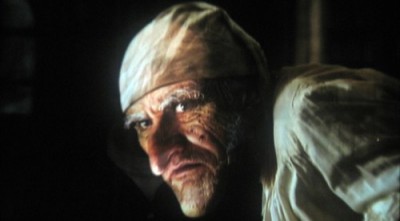
Where’s Mr. Magoo when you need him?
Art Art &Commentary &Disney 02 Apr 2009 07:50 am
SF Museum & Paul Glabicki gallery opening
 - Yesterday’s NYTimes featured an article about the forthcoming Walt Disney Family Museum to open in October in San Francisco. Former deputy director of the Harvard University Art Museums, Richard Benefield, will run the Museum. It’d be nice if a genuine animation historian were somehow involved.
- Yesterday’s NYTimes featured an article about the forthcoming Walt Disney Family Museum to open in October in San Francisco. Former deputy director of the Harvard University Art Museums, Richard Benefield, will run the Museum. It’d be nice if a genuine animation historian were somehow involved.
I enjoyed seeing the reason Diane Disney Miller gave for feeling the necessity of the museum. A 1994 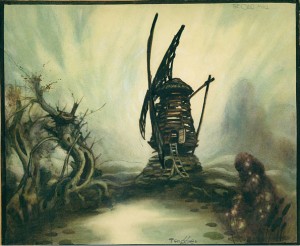 biography by Marc Eliot, “Walt Disney: Hollywood’s Dark Prince,†that depicted him as a bigot angered her. Neal Gabler’s book, “Walt Disney: The Triumph of the American Imagination,†also upset her. That book gave an unflattering picture of Disney’s marriage, despite the fact that the family opened all their records to Gabler.
biography by Marc Eliot, “Walt Disney: Hollywood’s Dark Prince,†that depicted him as a bigot angered her. Neal Gabler’s book, “Walt Disney: The Triumph of the American Imagination,†also upset her. That book gave an unflattering picture of Disney’s marriage, despite the fact that the family opened all their records to Gabler.
Ms. Miller also feels that the “Empire” has passed Walt over as a person in their attempt to globally brand the Disney name. Reportedly, this comment has confused the directors of studio Disney. After all, “. . . the company recently issued collectible figurines in his likeness and runs a fan club and magazine dedicated to him.”
Diane Disney Miller hopes the museum will portray a complete picture of her father, offering positive as well as not-so-positive material to the public. The museum will include, for example, a video about Disney’s friendly testimony before the House Un-American Activities Committee in 1947 and acknowledge the bitter animators’ strike in 1941.
Too bad the SF Chronicle won’t be around to give us a good report on the opening. Regardless, I’ll have to schedule a trip to the city to see this site once it opens. In the meantime, the Museum’s site is already up and running offering some bits of information and an operating book store (which doesn’t sell Gabler’s book, but does offer numerous John Canemaker tomes.)
- April 4th through May 9 Paul Glabicki will have a solo show in NYC at the Kim Foster Gallery, 529 West 20th St. in NYC.
Paul is a friend who came up through the film world at about the same time as I. His interest was always more into the experimental, Independent film, and his work was always exquisitely detailed and complex films. We often found each other at the same festivals in differing categories.
I received some information about his upcoming show, and I’m posting some of the information and statements that were sent me by the gallery.
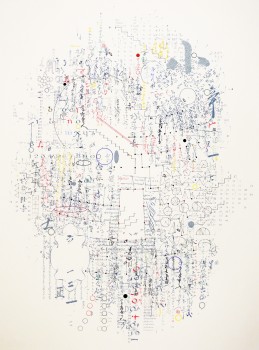 Paul Glabicki is an experimental film animator whose work has appeared at major film festivals, as well as national and international museum exhibitions. His animation work has been carefully crafted by means of thousands of meticulous hand-drawn images on paper. His films have screened at such prestigious sites as the New York Film Festival at Lincoln Center, the Cannes Film Festival, the Museum of Modern Art and the Whitney Museum of Art in New York, and the Venice Biennale. He has received numerous awards, grants, and fellowships, including a Guggenheim Fellowship. Grants from the National Endowment for the Arts, the Amencan Film Institute, and several grants from the Pennsylvania Council on the Arts.
Paul Glabicki is an experimental film animator whose work has appeared at major film festivals, as well as national and international museum exhibitions. His animation work has been carefully crafted by means of thousands of meticulous hand-drawn images on paper. His films have screened at such prestigious sites as the New York Film Festival at Lincoln Center, the Cannes Film Festival, the Museum of Modern Art and the Whitney Museum of Art in New York, and the Venice Biennale. He has received numerous awards, grants, and fellowships, including a Guggenheim Fellowship. Grants from the National Endowment for the Arts, the Amencan Film Institute, and several grants from the Pennsylvania Council on the Arts.
His new drawing series titled “ACCOUNTING for…” began with a Japanese artifact acquired by the artist several years ago: an accounting ledger book dating from the 1930s.
The relentless record keeping, the beauty of the mark-making, musings about its contents and purpose, the fact that it survived and came into his possession, the patterns that emerged when the book was carefully taken apart and arranged on a wall, the suggestion (by changes in the writing style) that more than one person made the marks, and other thoughts, images, and responses grew out of the artist’s interaction with the book.
Paul was interested in the book as a found personal, temporal object imbedded with meaning, function and mystery. Most intriguing to him was the fact that it made a leap from past to present written day-by-day; month-by-month, entry-by-entry, mundane and utilitarian (not intended to be an aesthetic object), recorded in time, and revealing patterns and rhythm over the duration of its writing.
The opening reception is Saturday April 4th 6-8pm.
You can see a 10 min short by Paul, Object Coverstion, on YouTube here.
Commentary 01 Apr 2009 07:42 am
Bluth & Banjo – 2
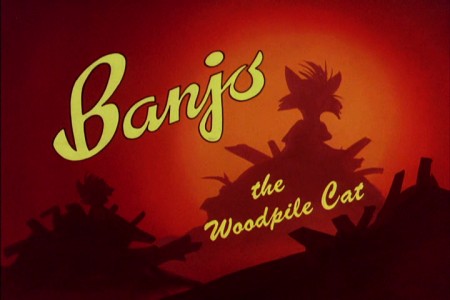
- Banjo the Woodpile Cat first aired on ABC on May 1, 1982, and that’s the first time I actually got to see the film. As I stated yesterday, there was a long wait for this one and a lot of hope and excitement in anticipation.
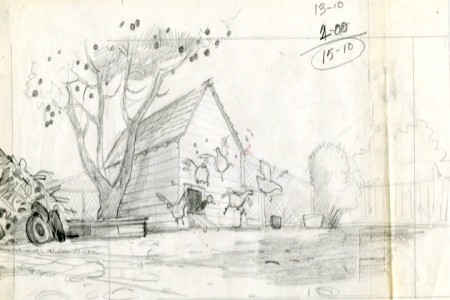
(Click any image to enlarge.)
The film wasn’t all that I’d anticipated. I had real problems with the story, however the animation was so much better than what we were used to seeing that it was obvious that better things were coming.
The story seemed to be little more than a bunch of vignettes hung together by the weakest of threads. A frustrated kitten heads out for the road and gets lost. An older cat, excellently voiced by Scatman Crouthers, helps him out, and he returns home.
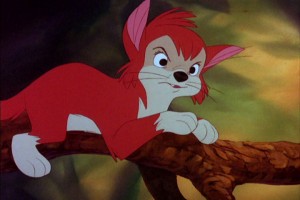 The film is tied together by some poor songs which accent any hokeyness the film has in its underbelly.
The film is tied together by some poor songs which accent any hokeyness the film has in its underbelly.
The quality of the animation was feature theatrical in nature and was at least equal to the animation that was coming out of the Disney studio.
I had been bothered by the poor and shallow short, The Small One. All style had left the films and the music by Robert Brunner (who also scored Banjo) was too popular and without the heft that that story needed. The movement, I think, was certainly not up to the quality of Banjo.
That same year, The Secret of Nimh was released. This was a solid meal from the Bluth people. They had jumped from something so mediocre in Banjo, to something far superior to anything that Disney had done since The Sword in the Stone.. It was obvious that Banjo was a primer – an exercise to move the fledgling studio forward, and it was a success. A new competitor was born.
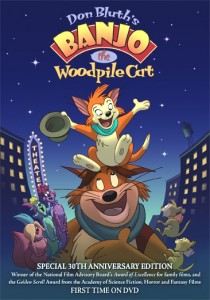 Now a DVD has been released of Banjo the Woodpile Cat, and it comes with a number of extra documentaries. As a piece of history, this is a must-have for animation enthusiasts. It was the stepping stone to something that moved animation forward. Without those industrious people at Bluth’s studio, the small rebirth of animation in the 90s wouldn’t have happened. The Little Mermaid, Beauty and the Beast et al are all the outgrowth of these steps taken by that rebellious group.
Now a DVD has been released of Banjo the Woodpile Cat, and it comes with a number of extra documentaries. As a piece of history, this is a must-have for animation enthusiasts. It was the stepping stone to something that moved animation forward. Without those industrious people at Bluth’s studio, the small rebirth of animation in the 90s wouldn’t have happened. The Little Mermaid, Beauty and the Beast et al are all the outgrowth of these steps taken by that rebellious group.
It was a hard move for them to have made, but they did so knowing full well that they were right. The end results have confirmed it.
My only sadness is the the Bluth studio isn’t moving forward with more features. I’m sure it’s difficult in these 3D days, and the energy required is for the young, but I wish he could engender the cash to continue on with the medium.
Don Bluth and his partners and studio deserve a couple of books to properly place them in animation history. You can be sure that I’ll have more to say on the subject soon.
.
All images come from the dvd and are
copyright © 2009 Don Bluth Films, All Rights Reserved.
.

